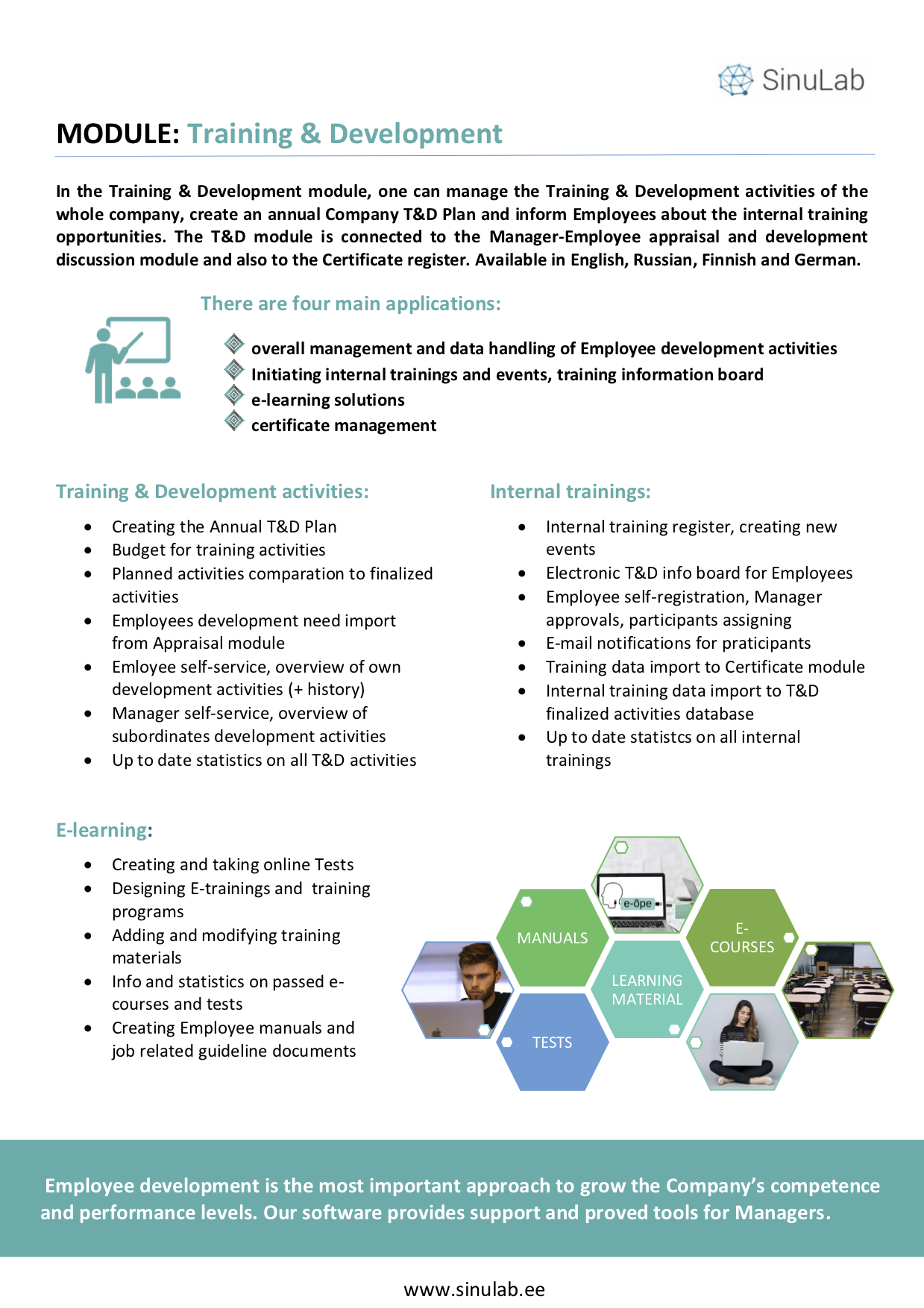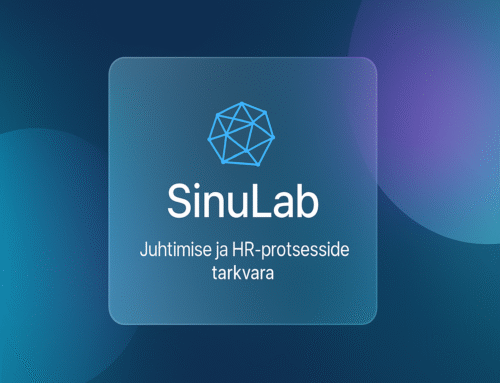Text: Maarit Vabrit-Raadla

It is positive to notice that companies are increasingly seeking and searching for ways and solutions to adopt modern learning methods. As a result of several conversations and consultations, I have picked out two main reasons for starting with e-learning in a company or re-organizing it for smoother and more operative implementation.
One of the reasons is that e-learning helps to make the whole learning process easier and faster. Both from the learner’s point of view who can acquire the necessary knowledge and skills at the suitable time in a format that allows time and location flexibility as well for the whole training and learning process in an organization. Learning process often (hopefully) starts with identifying needs, finding and selecting appropriate learning materials, and organizing participation, which in some cases can be quite a time and resource consuming (eg applying for training, validating expenses, invoicing-approving-paying, keeping records of training costs, etc.). For sure, it would be nice if the participant also provided the organization with feedback and an assessment of whether the investment fulfilled its purpose and whether the participant had acquired the expected knowledge or skills.
Another reason has been that a company operating in a specific area has a great deal of need to train its employees internally. There is a lot of information and knowledge that needs to be delivered in order to develop these critical competencies and skills.
On the one hand, it is suggested to automate such learning needs as learning-bites, but at the same time companies need to be sure that the quality of the training material is high level, relevant and ensures that the company employees will develop the necessary competence.
Both of these above mentioned reasons are nowadays inevitable in order to provide the competencies companies need to run their business, which is one of the key competitive advantages in today’s rapidly changing business environment.
How the company’s learning and development activities are structured depends on the business area, the nature of the work and how variable the line of business appears to be. For example, production and sales staff need frequent and flexible training on new products. For IT staff, the emphasis is more on self-study, team knowledge sharing and finding new information from different sources, such as e-learning bites.
Still, long-term development programs, entirely based on e-learning or combined with other methods, will remain. For example, while basic HTML knowledge and skills are sufficient for e-learning and self-practice, a combined approach, namely practical & classroom training and supportive e-learning, would be preferable for Leadership skills.
What is e-learning?
Common e-learning approaches are, for example, web-based self-study, watching / listening to video and audio recordings (podcasts), WBT (web-based training), combined e-learning, mobile learning, social learning, e-learning simulations, game-based learning.
There are also different ways of e-learning. A distinction is made between synchronous learning, which takes place in real time, and non-synchronous, time-independent learning. For example, instant messaging solutions, as well as audio and / or video conferencing, live event broadcasting, online application sharing, polls and a virtual training or learning environment are considered as synchronous learning methods.
Non-synchronous learning takes place regardless of time, as the learner chooses the time and pace of how and when to complete the topic or course, for example by e-mail and in forums. For example, audio or video materials, Wikipedia and blogs, event and conference recordings, simulations, game-based learning solutions.
How aware are companies of using e-learning solutions?
In 2018, a survey was conducted among Estonian small and medium-sized enterprises (Master’s thesis at the Institute of Business Administration at TalTech), which examined, among other things, employee development activities. It was also examined whether and to what extent small and medium-sized enterprises use software solutions to develop their employees and how aware they are of the various possibilities.
The most commonly used software solutions for employee development are:
- applications for team communication and information sharing – 31%;
- employee surveys – 29%;
- on-the-job learning – 22%.
The least mentioned were software solutions for career management, competency assessment, key-position succession and competence development.
A large number of companies – 56% in total – do not plan to implement such software solutions in the next two years. However, 22% of companies see that within the next two years they will implement the following software solutions for employee development:
- applications for team communication and information exchange;
- assessment of employee performance;
- performance or development discussions;
- e-learning solutions (e-trainings, simulations).
If we loo a bit further what is the situation in European SMEs, the EUROPEAN-WIDE E-LEARNING RECOGNITION REVIEW REPORT (2015) concludes that:
- The most liked learning in SMEs is informal one and the predominant training method is workplace training for daily tasks as it is viewed as “low cost” (Admiraal and Lockhorst, 2009).
- The integration with formal strategic training is often not planned. Also, the blending of face to face training with self-paced e-learning is not efficiently used (O’Brien and Hamburg, 2014).
- Due to limited financial resources managers often reduce learning activities and also the introduction of new technologies in their companies. According to other studies e-learning is not in high demand with SMEs although it is a suitable medium to quickly update the typical training requirements of SMEs (Beer et al., 2008; Hamburg and O’Brien, 2013).
- Research by Bryan (2006) and Spicer and Sadler-Smith (2006) show a – weak and sometimes inconsistent – causal relationship between training or organizational learning and performance in SMEs.
a
How and where to start?
So what do you need to consider if you have decided to start designing a systematic e-learning model for your company or if you want to increase the share of e-learning in order to be significantly effective in the development of key competencies for your company?
We suggest to start with mapping the current activities and future expectations.
- What problem or need do you want to solve with e-learning exactly?
- Who is the target group? Who is it meant for?
- Are the needs of the target group specifically formulated?
- Is the learning process mapped?
- What are the risks and benefits?
- Where and how is e-Learning actually organized/carried out (channels, platforms, solutions, etc.)?
- What are the expected outcomes? What has changed?
- What are the benefits for the company?
- What is the longer vision for e-learning in the company?
It is important for the company to think about the cost-related investment and how much financial resources can be planned in next year or in the long-term.
Examples of costs associated with e-learning include:
- Technology, including IT hardware, systems, software and applications, interfaces, infrastructure;
- Content creation & design, people or partners who create content and are responsible for keeping it up to date;
- Applications by which content is created and presented as training, such as e-learning platforms and user portals, video processing and design apps.
a
Some suggestions and ideas for organizing e-learning in small and medium-sized businesses
- E-learning system should not be complicated. Rather, the processes should be simple and easily adaptable to the company’s needs.
- In smaller companies, it is possible and sensible to start designing e-learning with simple and convenient ways, such as sharing manuals, videos and visuals on employee channels (intranet, electronic manuals, learning environment, etc.). The prerequisite is that the data/materials are digital.
- Start with some specific areas and needs that are relevant in the near future. For example, if the company is in the fast-growing phase it is important that new employees get on-boarded as smoothly and quickly as possible. During On-boarding a HR specialist or Line Manager verbally transmits the same information to each newcomer, which is very time consuming. Instead, some topics could be available through e-learning. This allows the new employee to acquire relevant information or knowledge at their own pace and at the appropriate time.
- Partner with Specialists to consult for the preparation of study materials. Collaboration does not have to be bulky and expensive, but it is important to understand the basics of creating and distributing e-learning and training materials. In e-learning, it is also important to think that the learner’s interest and motivation to acquire information and understands how to use it in the future, is maintained and directed.
- It is important to think about the expectations and needs related to the administration of e-learning, such as what kind of statistical indicators of e-learning you need to gather: time, number of attempts, e-learning completion rates, etc.
- Think about the company’s expectations and needs now, in the coming years, and in the longer term. What is the desired e-learning model you would like to reach at some point?
- It takes patience, time, testing and customization to design any new system, so is with e-learning system.
SinuLab Performance & People software has designed a digital solution where to create and manage company internal trainings and e-learning data and activities. The SinuLab e-learning module is easy to use for both the Manager and the Employee.
Read more about SinuLab digital training and e-learning solutions: Trainings and e-learning module intro






Leave A Comment